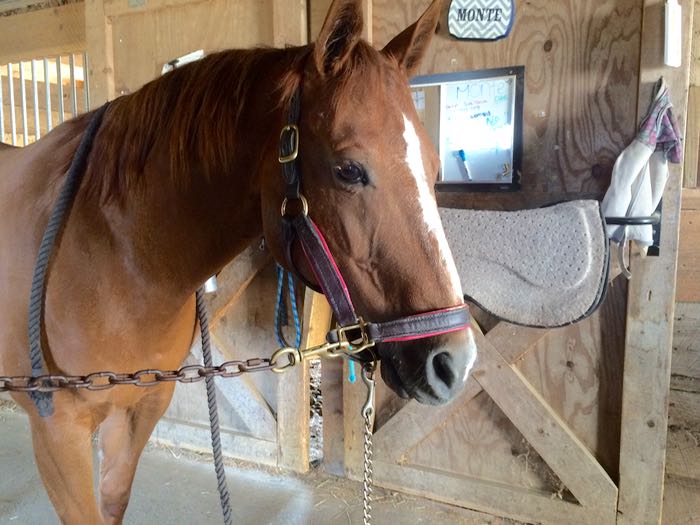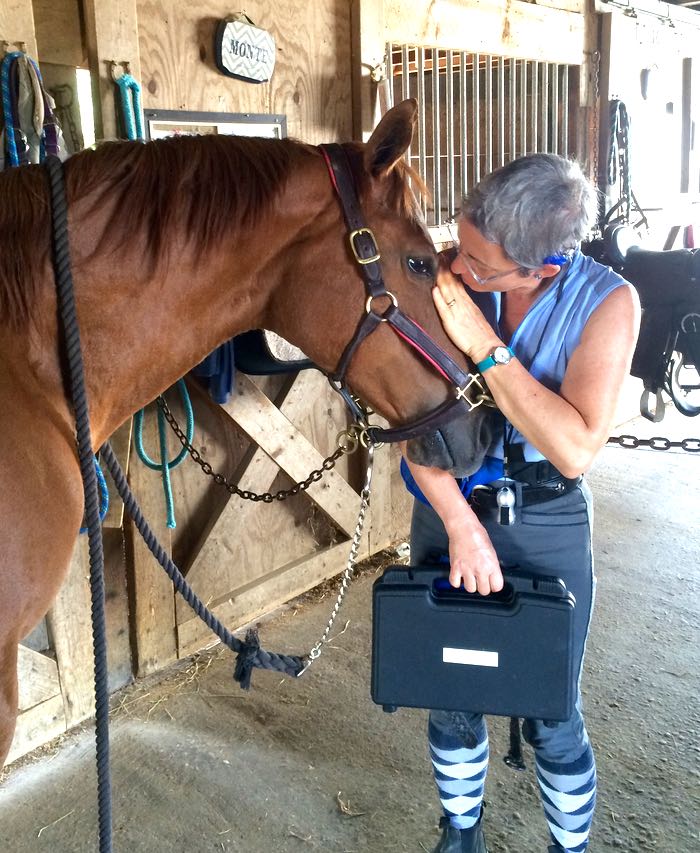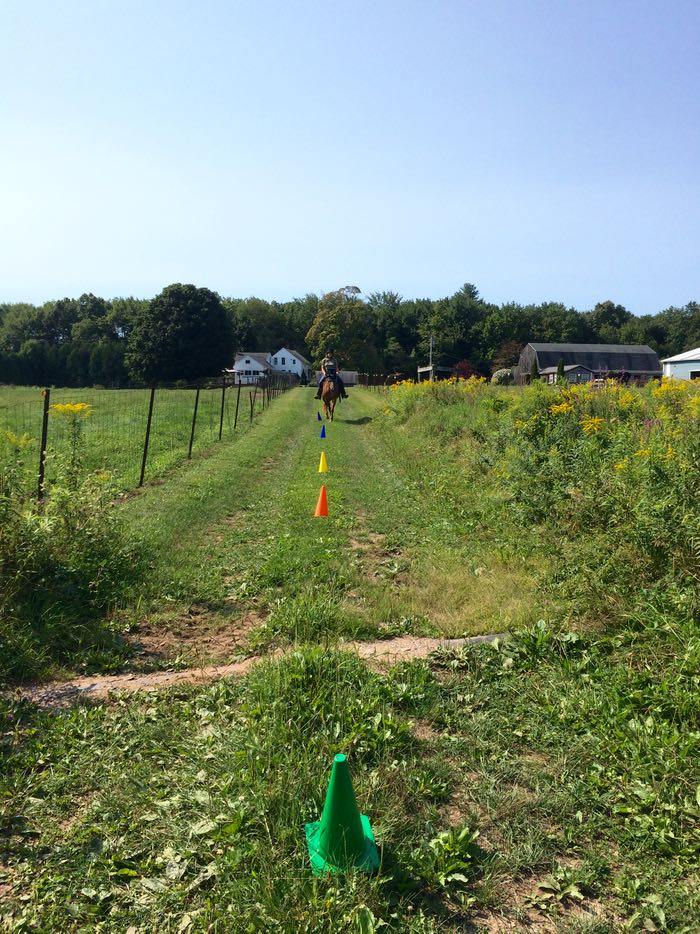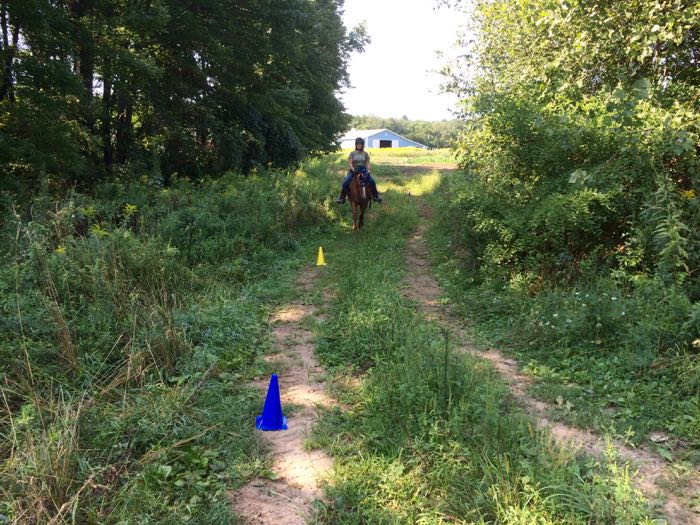Note: this blog is the third in a continuing series about training Bailey, and her person, Lisa. You might want to start here.
It was a month before I could return to work with Lisa and Bailey. It was a hot and humid August, not the best riding weather, but the pair did their homework as best they could. I had a couple reports of progress from Lisa – situations that in the past Bailey would have reacted to with fear, but instead now faced calmly.
When I arrived at the barn, it was immediately obvious that their relationship had improved because it spilled over to how the mare related to me. Do you remember this face? This is what Bailey thought of me when we first met.

This is how she greeted me two months later:

This is what happens when your horse is listened to and when their world makes sense. That soft eye is a window to what’s going on in her mind.
I’d only worked with Bailey twice in person, but both times everything that I did was reinforcing to her, and this is how she rewarded me, with clear affection.

(BTW, that case is an
Auto Amazon Links: No products found.
When you sit on a horse, they feel everything – your breath, whether a muscle is tense or relaxed, whether you’re tight in a shoulder, or have weight on one leg more than another. If you turn your head to look at something they feel the movement and they’re going to look, too.
Are you sitting in a chair? Look down and to your right. What just happened to the weight in your sitting bones? That shift is enough to change what the horse does under you. Looking down blocks forward movement and puts the horse off-balance. Lisa, worried about Bailey darting out from under her, rode with her eyes cast on Bailey’s shoulder. I knew that if I could change that, I’d create a domino effect to fix other issues interfering with their communication. I created an exercise that would make her look up and ride square, so that Bailey could walk ahead with confidence.
We started in the ring. I set out colored cones for Lisa to weave Bailey through. Lisa had to look from one cone to the next. Her head and shoulders lifted. She sat plumb. It turned out that Bailey loves patterns and she eagerly wove between the cones. Here was something that the mare understood and could excel at!
Next I moved the cones to the grass on the other side of the ring. Bailey, who usually in an unenclosed space, tensed and warily looked around, instead stayed focused on the cones. Lisa remained relaxed, eyes ahead. We progressed across the lawn and over to the trail. I think that I did the most work, picking up cones, and hurrying ahead to have them in place! Both Bailey and Lisa simply walked forward and would then stop and wait for me to catch up. There were rewards of pats, praise and cookies.

We approached the section of the trail that both had become fearful of. But this time, Lisa was deep into her saddle, looking confidently ahead to the last cone. Bailey was in her cowpony mode, working hard at the task. On they walked with nary a sideways glance at what usually worried them.

As we progressed, I did the two steps forward, one step back. Once Lisa reached me, I had her weave back through the cones towards the barn, and then back again to me. In the past the mare had rushed home; now she walked both directions with purpose. I spaced the cones further apart. Then we reached the dip in the trail, with poor sight lines, that Bailey was convinced led to a field inhabited by ogres. It was here that she had a history of wheeling around and bolting for the barn. But this time there was a cone in front of her, which Lisa looked squarely at, and Bailey walked calmly to. Much praise was showered on both of them.
Here is a video. If I hadn’t told you, would you ever believe that this good little mare was labeled “hot” and got so jumpy and jiggy that her rider would have to get off and walk home?
I’m going back in a couple of days. I look forward to having another pleasant walk down the trail.


The big smile on Lisa’s face–and the nice little mare waiting expectantly but calmly for her cookie–brought tears to my eyes. Such a frightened and resistant horse, to start with, and with a novice and so anxious–understandably–rider–and now we see what a healthy and happy path they’re traveling on. Bravo, Terry.
Thanks, Karen.
I was wondering if you would have some advice on getting a mule into a trailer….she is so afraid of it…she is also shy of men…loud voices….but once in she is calm….when she is packed up to go up the trail she is sweet calm, and wonderful….she calmly packs out elk quarters…she calmly walks trails. Her biggest challenge is getting caught by a male person and getting loaded into the trailer….when she is finally in she is calm…except this last time…they gave up for fear of hurting her or them selves….she lost her companion which was a male goat…any advice? Thanks Terry:)
I have a not so secret love of mules! Yours sounds wonderful. I wish you were nearby and I’d be right over to help. Unlike horses, a mule’s first reaction to a fearful situation is to plant all four and not budge. I’d start with by enlisting one man to become her friend. He should never ask her to do anything – he should just be there. Kind, quiet, doling out treats. When she sees him coming and looks up with happy anticipation, then you’re ready for the next step. If scary men have always gotten her onto trailers, then only use women to help you load. Also, take your time and load and unload her without restraint. Feed her in the trailer. Can you park it in her field so that she can explore it on her own? I don’t know if she had a bad experience on the road that we don’t know about. So, you might have to continue the desensitizing with very short trips that end in the equivalent of a mule party.
Those are some really good ideas, the trailer in the pasture was something I thought might work….we will begin and I will let you know how it goes, thanks for this blog site Terry….
One of my college roommates went on to become a pediatric burn unit nurse. I cannot imagine what she must deal with each day. I asked her once what were the most important tools in helping these kids as their nurse. I thought she was going to tell me all about some fancy debridement equipment, or a specific pain relief medication. But she didn’t hesitate: “colorful cartoon character band-aids, and lots and lots of balloons”. She was absolutely serious. She explained that in kid speak, band-aids make everything better; they validate that the boo-boo exists, and a colorful testament that someone noticed and did something specific to make them feel better. Often, the burns are so extensive, she has to place them on some unburned patch of skin. And, she said, no kid fails to smile when a bunch of balloon strings is placed in their hand, no matter how sick they are or how painful the treatment was that they just completed.
With horses, I honestly think a soft hand, a soothing voice and a pocketful of peppermints does just about the same thing. (Of course….it helps to have an insightful trainer who speaks both horse and people.)
Personally, I’m not at all fond of peppermints. It’s funny how they seem to be universally loved by horses! I’ve even found that horses have a preference for the hard ones, of a certain size, that crunch. I have preferences too – some have wrappers too hard to get off and the horse becomes impatient
I love the idea of using a row of cones. Brilliant!
It helps to have them of different colors.
Brilliant, wonderful outcome. Very well done to yourself, Lisa and Bailey. As I have said before just shows what patience and understanding can do….:)
Still having trouble with webcams even through link, is this something my end. Really missing the cams…:(
Webcams might be a permanent problem. The server changed protocols 🙁
Even to someone like me with very little experience of horses, the difference in Bailey’s eye in the first two photos is amazing. It’s funny how even if you don’t know horses well you can actually see the fear and distrust in the eye in the first photo, plus the raising of the head. She looks so much more relaxed in the second photo.
The three of you are doing an amazing job.
Thanks for your comment, Carol. It’s that transformation which is why I do what I do.